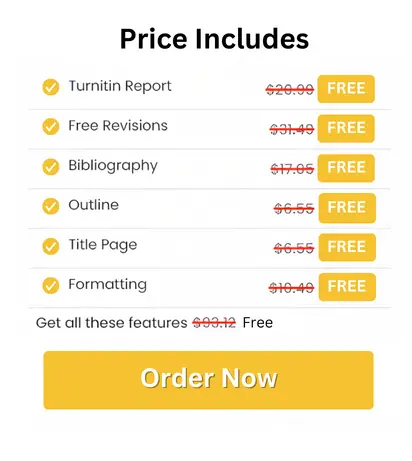
ETCH304 Diverse Literacy and Numeracy Learners Report 1 Sample
For the assessment task you will need to prepare a report on contemporary research and practices on the significance of functional and social literacy and numeracy for young children within their community contexts; as well as the pedagogical practices and approaches required to create differentiated learning environments and opportunities that acknowledge young children’s literacy and numeracy diversity.
Ensure your report addresses:
Part A: English as an additional language
• Discuss how literacy and numeracy is a functional and social practice and how this view helps early childhood teachers to understand and value diverse literacy and numeracy practices for children with English as an additional language.
• Identify the practices that teachers can engage in to acknowledge, value, and teach these diverse literacy and numeracy practices for children with English as an additional language.
• Critically evaluate two educational resources that would be advantageous for professional development in the context of teaching children who have English as an additional language.
Part B: Aboriginal and Torres Strait islander
• Discuss how literacy and numeracy is a functional and social practice and how this view helps early childhood teachers to understand and value diverse literacy and numeracy practices for Aboriginal and Torres Strait Islander children.
• Identify the practices that teachers can engage in to acknowledge, value, and teach these diverse literacy and numeracy practices for Aboriginal and Torres Strait Islander children.
• Critically evaluate two resources that would be beneficial for professional learning for Aboriginal and Torres Strait Islander children.
Part C: Exceptionalities
• Discuss how literacy and numeracy is a functional and social practice and how this view helps early childhood teachers to understand and value diverse literacy and numeracy practices for children with exceptionalities.
• Identify the practices that teachers can engage in to acknowledge, value, and teach these diverse literacy and numeracy practices for children with exceptionalities.
• Critically evaluate two resources that would be beneficial for professional learning for children with exceptionalities.
Solution
Introduction
There is much more to the elemental literacy, numeracy, and reading skills that serve as the foundation of education. These abilities are woven through our interactions and perceptions of the world. This report characterizes useful proficiency and numeracy as the capacity to apply these abilities in significant, real-world settings. Effective utilisation of social literacy and numeracy skills requires teamwork, communication, and social affectability. Early childhood education envelops a wide extent of circumstances when it comes to the concept of diverse learners. All children who speak English as a second language (EAL), have exceptionalities or are Aboriginal or Torres Strait Islander are included (Price & Slee, 2021). Each group provides specific needs and qualities to the learning environment. Teachers working with youthful children can go beyond traditional strategies of instruction once they understand the social and functional viewpoints of literacy and numeracy (Clements & Sarama, 2020). A diversity-centered approach is one way that educators can design adaptable learning environments.
As per this report, a functional and social point of view for university assignment help on literacy and numeracy is vital to support different learners in early childhood settings. It will look at how this point of view makes a difference in instructors to distinguish and esteem the unique learning styles of EAL children, Aboriginal and Torres Strait Islander children, and exceptional children. Examining particular pedagogical techniques and resources that promote comprehensive learning environments and help all children lay a solid establishment in perusing and numeracy is the objective of this report. Giving need to these diverse points of view allows educators to create learning opportunities that are not as it were successful but also empower the next generation.
English as an Additional Language (EAL)
Literacy and Numeracy as Functional and Social Practices
Traditionally, the focus of reading comprehension and numeracy instruction has been on discrete skills like math, spelling, and text decoding (Hannify & Raftery, 2023). Viewed from a functional and social perspective, however, these abilities are far more profound. Literacy and numeracy are the foundations of being able to navigate and understand the world. These are closely related to the ability to communicate effectively on a social level, be culturally aware, and deal with others.
Especially for children learning English as a second language (EAL), this functional and social perspective is important. It modifies the perspective so that math and language skills are not solely evaluated by English fluency. Rather, it recognizes that EAL children complement the classroom with a diverse range of linguistic and cultural experiences (Arslan, 2023). Their distinct method of learning is shaped by their home language practices, which include various forms of storytelling, emotional expression, and mathematical comprehension.
Educators can comprehend English language learners more deeply when they value the variety of literacy and numeracy practices. This integrated approach assists educators in identifying the assets of each student, bridging the gaps between the home and school settings, and utilizing children's past knowledge to link to new ideas.
Pedagogical Practices
Changing teaching tactics to create an inclusive and accommodating learning environment for EAL children is necessary to acknowledge varied literacy and numeracy practices. The following are some crucial methods:
Providing Multilingual Resources: Understanding is facilitated when children are exposed to resources and materials in both their native tongue and English. Some examples of this could be multilingual online resources, picture dictionaries that are bilingual, and translated worksheets.
Incorporating Home Language: It demonstrates respect for a child's linguistic identity to support them in using their native tongue, even in tiny ways. When learning new concepts in English, it can act as a bridge (de Pinho Correia Ibrahim, 2020). One strategy is to label classroom supplies in multiple languages or to have multilingual books and resources accessible.
Using Visuals: When it comes to supporting comprehension in EAL learners, visual aids such as charts, diagrams, pictures, and real-world objects are invaluable (De Oliveira & Westerlund, 2022). They give context for new vocabulary and assist in making abstract ideas more concrete.
Differentiating Learning Environments: To enhance their language development, EAL children gain from a range of educational opportunities. Peer cooperation, individual practice opportunities, and whole-group instruction mixed with small-group activities are all included (Oxley, Nash & Weighall, 2022). EAL children can develop a sense of agency by being given options and utilising adaptable grouping techniques.
Practical Examples
Measurement is a math lesson where children measure things in the classroom in pairs. Both English and the student's native tongues are encouraged for communication and recording of findings, and a visual chart is used by the teacher to provide instructions in both languages.
To aid EAL children in understanding, a teacher reads aloud in English a story while using gestures and pictures. A teacher-led group discussion follows, during which the children are invited to share comparable experiences or tales from their own cultures.
Resource Evaluation
Resource 1
For educators assisting young EAL children, this handbook by Clarke and OAM (2009) “Supporting Children Learning English as a Second Language in the Early Years (birth to six years)” offers useful strategies. In order Tolanguage development, it emphasizes the significance of nurturing surroundings, appreciating native tongues, and employing age-appropriate exercises. It promotes a positive, strengths-based approach to supporting young EAL children, stresses play-based learning, and provides specific examples. But there are some potential weaknesses as well like less emphasis is placed on numeracy skills, and educators looking for a more in-depth linguistic analysis may need to use additional resources. Overall, these materials advance knowledge about the variety of literacy and numeracy approaches used by EAL children. Combining different kinds of resources can be especially beneficial for educators.
Resource 2
A selection of the professional development resources offered by the Australian Council of TESOL Associations (ACTA) include publications, webinars, and workshops focused on EAL education. It focuses on best practices and current research in the field, offers a variety of learning opportunities, and encourages networking among educators. There are some drawbacks as educators may have to actively look for subjects that are especially pertinent to early childhood contexts, and some resources may require membership to access.
Aboriginal and Torres Strait Islander Children
Literacy and Numeracy as Functional and Social Practices
Reading, numeracy, and thousands of years of cultural knowledge, customs, and worldviews are all intricately entwined for children who are Aboriginal and Torres Strait Islander. Instead of adopting a deficit view that only considers Western academic standards, a functional and social perspective acknowledges the importance of these rich knowledge systems.
Aboriginal and Torres Strait Islander cultures are centred on oral traditions. Transmission of knowledge, values, beliefs, and history across generations can be effectively achieved through storytelling, song, and dance (Port, 2020). Comprehensive literacy development is facilitated by these practices, which also develop creative expression, sophisticated communication skills, and the capacity to decipher symbolic meanings.
Native Australian and Torres Strait Islander cultures rely heavily on visual representations and spatial knowledge (Simone, 2022). An appreciation of patterns and relationships in the natural world, proficiency with mapping, and traditional art forms are examples of this. Together with a strong sense of place and territory, these practices require complex mathematical reasoning.
When educators adopt this more inclusive perspective on literacy and numeracy, they develop an appreciation for the variety of ways that Aboriginal and Torres Strait Islander children learn and interact. Educators can create a sense of belonging and cultural pride in Indigenous children by using this perspective to help them make connections between the home and school environments.
Pedagogical Practices
Reactive and inclusive learning environments for Aboriginal and Torres Strait Islander children are produced when these varied practices are acknowledged and integrated into early childhood settings. The following are some crucial methods:
Community Involvement: One way to foster intergenerational learning and a sense of belonging to one's country is to invite elders and community members into the classroom (Jackson-Barrett, 2021).
Land-Based Learning: Observation skills, a strong sense of place, and an appreciation of ecological principles are all enhanced by moving to learn outside and incorporating activities centred around natural settings.
Storytelling: A love of storytelling, cultural awareness, and oral language development are all facilitated by incorporating classic Dreamtime tales and encouraging kids to tell their own (Cumming-Potvin, Jackson-Barrett & Potvin, 2022).
Culturally Relevant Materials: It validates children's lived experiences and provides opportunities for meaningful learning when books, songs, and other materials that represent Aboriginal and Torres Strait Islander perspectives and traditions are used (EYLF Outcome 5 Children are effective communicators. n.d.).
Practical Examples
A dreamtime tale about the natural world is shared by a local elder, invited by an educator. A group discussion is held after the children have finished creating their drawings or paintings of the narrative.
Kids gather leaves, sticks, and stones while out on a nature walk. After returning to the classroom, the teacher leads a lesson on utilizing these natural materials to sort, classify, and create patterns.
Overall, Respect for Aboriginal and Torres Strait Islander knowledge systems is shown by educators who use such culturally responsive practices. This improves student engagement, promotes a strong sense of identity, and allows Indigenous children to see their knowledge reflected in the curriculum.
Resource Evaluation
Resource 1
Mathematics instruction that is sensitive to the cultural background of Indigenous children is highlighted in the "Yumi Deadly Maths - Literacy in Mathematics" (2018) framework. The primary goals are addressing real-world problems, utilizing Indigenous knowledge, and encouraging specific mathematical literacy abilities. The relationship between acquiring mathematical knowledge and cultural viewpoints is heavily emphasised. demonstrates the value of two-way learning and offers classroom examples. Though it might require adjustments for the youngest children, early childhood settings can use it, including extra resources that concentrate on early childhood development could be beneficial for teachers.
Resource 2
Educators interested in culturally responsive early childhood practices can use the resources by SNAICC. The SNAICC looks out for the welfare and rights of children who are Aboriginal and Torres Strait Islander. It offers a variety of resources that address a broad range of early childhood-related subjects. Also, it prioritizes social justice, holistic child development, and Indigenous perspectives. Since the emphasis on overall development and well-being is growing, educators may also need to look for specialized resources regarding literacy and numeracy.
Children with Exceptionalities
Literacy and Numeracy as Functional and Social Practices
With a focus on strengths rather than weaknesses, this approach acknowledges that every child has unique abilities and learning styles. Understanding and helping children with exceptionalities critically depends on social and viable points of view on literacy and numeracy (Grigorenko et al., 2020).
It is simpler for educators to support children with exceptionalities in investigating their surroundings and creating a sense of agency when they teach these skills in both social and functional settings. Practical work, communication, and social instinct all depend on being proficient and numerate. By recognizing that each child's definition of victory is unique, educators can create objectives that are both significant and achievable for each student.
Individual differences in sensory experiences, communication styles, and information-processing strategies affect how children with extraordinary needs learn (Frolli et al., 2023). This is often highlighted by a useful and social approach. Educators are encouraged to come up with innovative thoughts for transforming the classroom and offering new chances for participation and communication.
Pedagogical Practices
Value and integration of a range of learning needs within a functional and social framework require effective and flexible teaching strategies. These are a few essential techniques:
UDL (Universal Design for Learning): Universal learning design prioritizes adaptability and accessibility early on in the lesson design process (Basham, Blackorby, and Marino, 2020). Offering a variety of choices and options to accommodate all children in the classroom entails offering several channels for representation, expression, and engagement.
Adaptive Technologies: Children with a variety of exceptionalities can be empowered and gaps can be filled by tools like word prediction software, speech-generating devices, and text-to-speech software. By using these resources, kids can learn on their own and improve their ability to express themselves.
Multi-Sensory Approaches: Learners with varying needs are supported when multiple senses are engaged through movement, sound, touch, and sight (Khasawneh, 2024). This entails teaching literacy and numeracy concepts through the use of photographs, manipulatives, music, and practical exercises.
Practical Examples
Educators use manipulatives like counters and blocks to help children understand number concepts while also providing visual aids. This makes mathematical relationships understandable to children in a way that suits their learning preferences, regardless of their learning style.
Using text-to-speech software to access written material can be beneficial for a dyslexic child (Wood et al., 2018). They can concentrate on understanding and actively participating in the text thanks to the software.
There are various ways that a teacher can help children show that they understand a story. To accommodate a range of communication styles, they can summarise the events orally, in writing, or visually.
These techniques help educators foster inclusive learning environments where kids with exceptionalities feel supported, appreciated, and inspired to realize their full potential. Educators can modify instruction and create learning opportunities that highlight the individual strengths and viewpoints of every child when they have a functional and social understanding of literacy and numeracy.
Resource Evaluation
Resource 1
Parents and educators who are supporting children with learning and thinking differences can find articles, professional advice, and interactive tools on the website “Understood.org”. It addresses common issues, offers individualized guidance, and offers a plethora of useful resources. focuses on subjects outside of academia, like self-advocacy and social-emotional skills. But there are some drawbacks such as, it can occasionally be overwhelming to absorb so much information. It might be necessary for educators to select particular materials that are pertinent to their teaching needs.
Resource 2
Chapters in the book "Diversity, Inclusion, and Engagement" by Hyde, Dole and Tait (2022) address particular exceptionalities and useful tactics, giving a thorough overview of inclusive education. It highlights cooperation between educators, families, and specialists and promotes a strengths-based approach. It presents a comprehensive perspective of inclusive education, offers in-depth talks about different exceptionalities, and offers particular teaching strategies. Even though the book is helpful, educators might need to supplement it with other resources because it may not provide comprehensive information about the newest technology tools or how UDL is implemented in early childhood settings exclusively.
Overall, for professional development in teaching children with exceptionalities, both resources are helpful. This book gives educators especially those who are new to the field of special education a solid theoretical foundation and useful strategies. In terms of answering educators' and parents' immediate questions and concerns, Understood.org shines due to its user-friendly layout. A balanced and all-encompassing approach to professional learning would be provided by ideally combining these resources.
Conclusion
Adopting a functional and social point of view of literacy and numeracy is significant for helping different learners in early childhood settings, as this report has highlighted. Utilizing functional and social points of view on literacy and numeracy in early childhood instruction can have a transformative impact, as this report has illustrated. The significance of home languages and cultural experiences is emphasized for children who are learning English as a second language (EAL). Viable methods that foster inclusivity for EAL learners incorporate the utilisation of visual help and multilingual resources. While working with kids who have exceptionalities, teachers make use of adaptive technologies, multisensory approaches, and Universal Design for Learning to ensure that all children are involved and able to participate. Teachers can help Indigenous children in Australia build a sense of cultural pride by using culturally relevant materials, community involvement, and storytelling. Teachers' access to ongoing professional development makes it possible for them to stay up to date on resources and best practices in the field. By being this committed, teachers can design all-inclusive classrooms where every student feels valued, inspired, and equipped to succeed.
References
Arslan, M. (2023). Analyzing Code-Switching Patterns in ESL teaching practices: A critical discourse analysis. Harf-o-Sukhan, 7(3), 192-213. https://harf-o-sukhan.com/index.php/Harf-o-sukhan/article/download/829/799
Australian Council of TESOL Associations. (n.d.) A selection of Australian tesol resources. https://tesol.org.au/resources/#resources-1
Basham, J. D., Blackorby, J., & Marino, M. T. (2020). Opportunity in crisis: The role of universal design for learning in educational redesign. Learning Disabilities: A Contemporary Journal, 18(1), 71-91. https://files.eric.ed.gov/fulltext/EJ1264277.pdf
Clarke, P., & OAM. (2009). Supporting Children Learning English as a Second Language in the Early Years (birth to six years). fletcherearlylearningcentre.com. https://www.fletcherearlylearningcentre.com.au/uploads/supporting_children_english_2nd_language.pdf
Clements, D. H., & Sarama, J. (2020). Learning and teaching early math: The learning trajectories approach. Routledge. https://doi.org/10.4324/9781003083528
Cumming-Potvin, W., Jackson-Barrett, L., & Potvin, D. (2022). Aboriginal perspectives matter: Yarning and reflecting about teaching literacies with multimodal Aboriginal texts. Issues in Educational Research, 32(4), 1342-1363. https://ro.ecu.edu.au/cgi/viewcontent.cgi?article=2792&context=ecuworks2022-2026
de Pinho Correia Ibrahim, M. N. (2020). The multilingual picturebook in English language teaching: Linguistic and cultural identity. https://nordopen.nord.no/nord-xmlui/bitstream/handle/11250/2732639/Ibrahim.pdf?sequence=2
EYLF Outcome 5 Children are effective communicators. (n.d.). Australian Children’s Education and Care Quality Authority. https://www.acecqa.gov.au/sites/default/files/2020-12/Outcome5-ChildrenAreEffectiveCommunicators-SNAICC.pdf
Frolli, A., Cerciello, F., Esposito, C., Ricci, M. C., Laccone, R. P., & Bisogni, F. (2023). Universal Design for Learning for children with ADHD. Children, 10(8), 1350. https://www.mdpi.com/2227-9067/10/8/1350
Grigorenko, E. L., Compton, D. L., Fuchs, L. S., Wagner, R. K., Willcutt, E. G., & Fletcher, J. M. (2020). Understanding, educating, and supporting children with specific learning disabilities: 50 years of science and practice. American Psychologist, 75(1), 37. https://www.ncbi.nlm.nih.gov/pmc/articles/PMC6851403/
Hannify, C., & Raftery, M. (2023). Assessing the efficacy of Morphological Analysis Intervention (MAI) with 4th class EAL pupils experiencing language and reading difficulties. REACH: Journal of Inclusive Education in Ireland, 36(2). https://www.reachjournal.ie/index.php/reach/article/download/552/527
Hyde, M., Dole, S., & Tait, K. (2022). Diversity, inclusion and engagement. Oxford University Press Australia & New Zealand. (Chapters 6 & 7).
Jackson-Barrett, E. M. (2021). On country learning: Towards a culturally responsive pedagogy for Aboriginal education (Doctoral dissertation, Murdoch University). https://researchportal.murdoch.edu.au/esploro/fulltext/doctoral/On-country-learning-Towards-a-culturally/991005543944907891?repId=12136217290007891&mId=13136842330007891&institution=61MUN_INST
Khasawneh, M. A. S. (2024). The Role of the Multi-Sensory Environment in Developing Learning Skills Among Students with Learning Difficulties in the Asir Region. Kurdish Studies, 12(1). https://kurdishstudies.net/menu-script/index.php/KS/article/download/1433/1051
Oxley, E., Nash, H., & Weighall, A. (2022). Overcoming the barriers facing children with English as an additional language: A Delphi study of teacher practices and perceptions in England. https://osf.io/kd3rs/download
Port, R. (2020). Aboriginal Contemporary Dance Practice: Embodying Our Ways of Being, Knowing and Doing through Dance Storying (Doctoral dissertation, University of Melbourne). https://minerva-access.unimelb.edu.au/bitstream/11343/277051/2/a02411b7-5a5e-e811-948b-0050568d7800_Public%20Access%20Copy%20Aboriginal%20Contemporary%20Dance%20FINAL.pdf
Price, D., & Slee, R. (2021). An Australian Curriculum that includes diverse learners: The case of students with disability. Curriculum Perspectives, 41(1), 71-81. https://www.academia.edu/download/88545927/s41297-021-00134-8.pdf
Simone, N. R. (2022). Teachers perspectives of embedding Aboriginal and Torres Strait Islander peoples' histories and cultures in mathematics (Doctoral dissertation, Queensland University of Technology). https://eprints.qut.edu.au/227459/1/Nicole_Simone_Thesis.pdf
SNAICC. Resources. https://www.snaicc.org.au/resources/?resource-type=educator-family-materials&resource-theme=early-childhood-education-care&=educator-family-materials&resource-business-unit=sector-development-resource&resource-jurisdiction=national
Understood. (n.d.). For learning and thinking differences. https://www.understood.org/en
Wood, S. G., Moxley, J. H., Tighe, E. L., & Wagner, R. K. (2018). Does use of text-to-speech and related read-aloud tools improve reading comprehension for students with reading disabilities? A meta-analysis. Journal of learning disabilities, 51(1), 73-84. https://www.ncbi.nlm.nih.gov/pmc/articles/PMC5494021/
Yumi Deadly Maths - Literacy in mathematics. (2018, June). QUT YuMi Deadly Centre. https://research.qut.edu.au/ydc/wp-content/uploads/sites/181/2019/12/YDM-SuppBook3-Literacy-in-Mathematics-2018.pdf




 81 Isla Avenue Glenroy, Mel, VIC, 3046 AU
81 Isla Avenue Glenroy, Mel, VIC, 3046 AU



